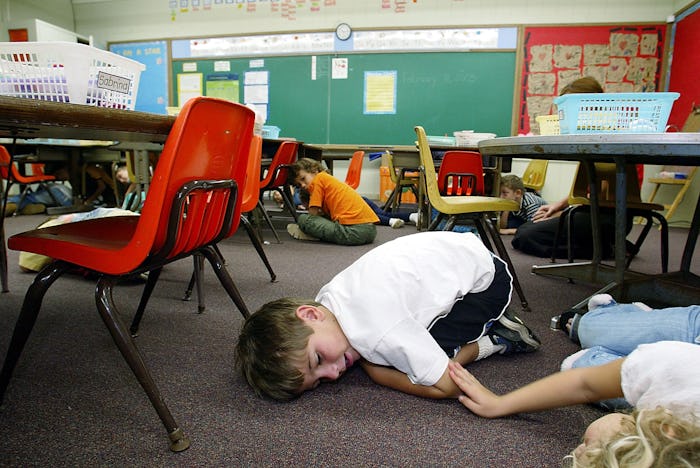News

I Have Heard Horror Stories About Lockdown Drills In Schools Across The U.S.
As I traveled across the country on my book tour over the summer to talk about gun violence and the movement to stop it, I heard horrifying story after story from parents — and even educators — about what American school children are being forced to endure during active-shooter drills.
One woman’s high-school-aged son drew a map to his girlfriend’s classes so he’d know where to go use his body as a shield to save her. Another woman said her eighth grader sobbed during a drill because he couldn’t leave his class to protect his younger sister. Another said her kindergartner wet her pants in class because she’s afraid she’ll get stranded in the bathroom during a drill. And the parent who said she’d started homeschooling her child to avoid drill-related anxiety.
Given our nation’s gun violence crisis and recent mass school shooting tragedies — from Sandy Hook to Parkland to Santa Fe — of course we’re all terrified of gun violence in schools. It makes sense for school staff and administrators to be prepared to respond to an active-shooter situation. But we should also be worried about what lockdown drills are doing to our children — and what it means to raise a generation we’re teaching to run, hide or fight before we’ve even taught them how to read.
Active-shooter drills are prevalent around the country, but the drill content is not standardized or well regulated, and too often they go too far. In Indiana, elementary school teachers were left with welts and bruises after they were lined up and shot execution-style with an airsoft rifle. In California, a janitor with a mask and fake gun ran around a school campus to purposely frighten faculty and students. And in Florida, a Code Red drill resulted in students briefly passing out, while other parents and students reported students suffering asthma attacks or vomiting from fear.
It’s not surprising to learn that experts are warning that these drills could inflict psychological trauma on children. Well-known child psychiatrists say that frightening circumstances can lead to lasting effects like depression, anxiety, poor sleep and worsening academic performance. Simultaneously, there is scant empirical research showing these drills improve outcomes for kids in actual active-shooter situations. Safe Havens, a school safety non-profit, found that people who go through options-based training like ALICE consistently performed “worse than people with no training whatsoever" in over 7,500 simulations.
And while any gun violence at our nation’s schools is unacceptable, the overemphasis on gun violence at school fails to acknowledge the reality that children are much more likely to be shot and killed at home in an act of domestic violence or an unintentional shooting than at school. Mass shootings — including school shootings — make up less than 1 percent of all gun deaths in the United States. Yet, thanks to the lockdown drills they’re enduring, a majority of American teens worry that a school shooting could happen at their school.
Our concern about school shootings too often takes priority over focusing on ways to stop the daily gun violence that is actually harming the most children in the United States. Black and Hispanic children and teens impacted by gun violence at much higher rates than their white peers in their communities due to policies that reduce resources and encourage segregation.
The most effective way to keep kids safe in their schools is to implement proven policies and programs that prevent violence in their communities. The data shows that generally school shooters are students who have shown warning signs and who accessed guns from the homes of family or friends. As many as 80 percent of the students committing gun violence on school grounds obtained their firearms from their home, their relative’s home or from friends, so we need policies to make sure students don’t have unauthorized access to firearms.
Gun safety laws like red flag laws empower law enforcement and families to temporarily remove a person’s access to guns when they present a serious risk to themselves or others. Secure storage policies and awareness will encourage parents to act responsibly and prevent children from having easy access to guns in their homes. And school boards have the power to adopt policies that increase student counseling options, upgrade security and implement evidence-based threat assessment programs that enable faculty to evaluate and intervene with students who may pose a risk to themselves or others.
Moms Demand Action volunteers across the country are meeting with their local school boards to educate them and urge them to enact these policies. Many have done so. But too often, instead of trying what we know will work, we continue to ask children to cower under desks, hide in closets, and pretend that active shooters are acts of nature because it’s easier for the adults to neglect the real causes of our gun violence crisis.
We shouldn’t be asking our children to stand up to gunmen; we should be telling our lawmakers to stand up to the gun lobby.
Shannon Watts, a mother of five, is the founder of Moms Demand Action for Gun Sense in America and the author of Fight Like a Mother: How a Grassroots Movement Took on the Gun Lobby and Why Women Will Change the World.
This article was originally published on